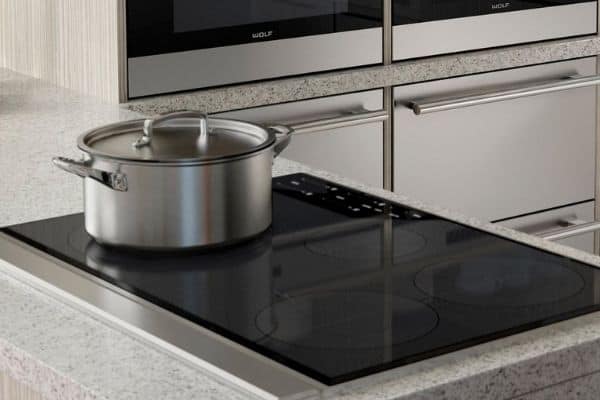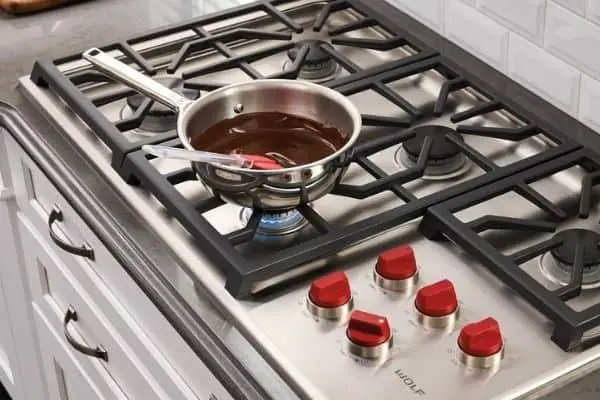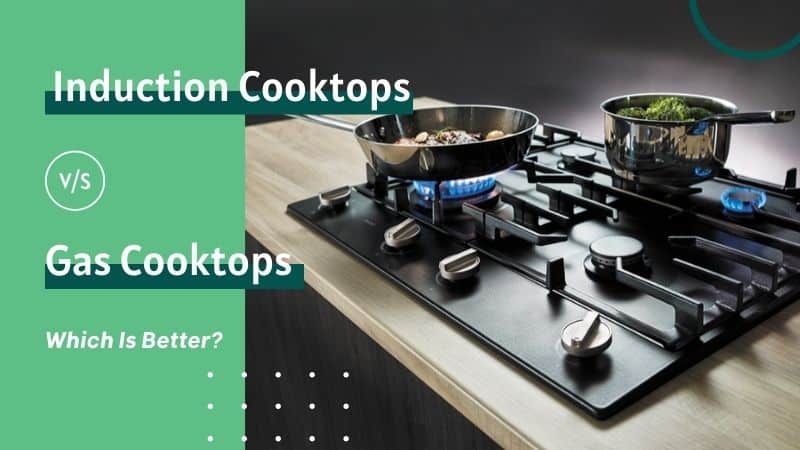There are many different types of cooking appliances that people can choose from. One type is the gas cooktop. Gas cooktops have been around for a long time, but induction stoves are becoming more popular as new technology emerges to make them better and more efficient.
If you are trying to decide which type of cooktops is best for you, induction vs gas cooktops, this article should help. This article will discuss the benefits of both types of stove, along with their drawbacks so you can choose which one might be best for your needs!
What is induction cooktop and gas cooktop?
Induction cooktop
Induction cooking is done by encircling the cookware with a copper wire and sending alternating electrical currents through it, producing an electric field. For effective induction, metal pans and pots such as cast iron or stainless steel are needed.

This method of cooking has a wide range of benefits. In contrast to gas cooktops, which convert heat to heat (flames) and then transfer it to cookware, the induction cooker uses a magnetic field to drive heat straight into the cookware.
It is possible to lay a towel on your burner and then place an oven or a pan on top, cooking the food in the pan or pot without danger of burning the towel. Induction is highly energy efficient, using 84% of the power needed to cook, compared to 40% for gas cooktops.
Gas cooktop
For many, the most common way of cooking for an extended period of time is using a gas stove. Additionally, they are preferable to electric cooktops.

Using natural gas or propane cooking stoves enables you to turn on or off the heat with the press of a button. In contrast to electric cooktops, which need preheating the grill of the burner before the source of heat is the fire itself. It begins heating when you turn it on. It does not if the heat is turned off. While the cooking surface may continue to be hot, this is insufficient to cook your meal.
The disadvantage of cooking with gas is the danger that it may offer. As with anything that utilizes gas, turning it on before to entering your house may pose a risk in the case of a malfunction, such as evaporation.
What are the differences between an induction cooktop and gas cooktop?
An induction cooktop uses electromagnetic currents to heat the pan through the magnetic field created by the stovetop.
Gas stoves require natural gas or propane to burn, transferring energy to the bottom of each pot or pan in much the same way an open flame would. One major advantage that your home might have is if it has access to natural gas lines that run into your kitchen (if you don’t know, then ask your landlord).
If not, one must purchase a propane tank and attach it to each burner in order for them to work. Another small benefit with using propane is that since you are cooking on top of it rather than heating up an entire area/oven like with electricity, it cooks faster.
Which is better for the environment?
With research showing that cooking with natural gas rather than electricity reduces greenhouse emissions, it would be best to get a gas stovetop. Seems like common sense, but some people think since electric cooktops don’t use any fossil fuels they are “greener.”
Make no mistake, electric stoves (induction or not) still require the generation of power which ultimately leads to more greenhouse gases. It’s important to note that unless you can derive clean energy from your source, anything that runs on electricity will be emitting carbon dioxide into the atmosphere.
There are ways around it (solar, windmills, etc.), but these aren’t viable options for every household in every area.
In short: gas stoves may not be as efficient as induction cooktops but they still produce less emissions and are more environmentally friendly.
Which is better for the money?
This answer depends on what part of the world you live in. In North America, gas ranges are cheaper than induction because electricity is not as prevalent (and sometimes even flat out unavailable) as it is in Europe or Asia, where an electric stovetop would be better.
The reason why gas ranges cost less for North Americans is that we don’t need to spend money on converting our power appliances from one type to another. Stove companies can just make gas ranges here since that’s what most people have at home already.
If you’re interested in saving some cash on your next stove and live in the US, perhaps opt for a gas range rather than an induction cooktop.
Which is easier to clean?
Induction stovetops generally require less cleaning since they don’t get as dirty as gas ranges do (typically because there is no open flame).
However, because you can’t control the temperature like with gas stoves, it’s advised that you keep your pots and pans very thin on an induction cooktop so that when one pot boils faster/more intensely than others, it doesn’t end up spilling over into other pots or burning food onto your burner.
Of course this depends on what kind of cook top you have – some are better about regulating heat flow naturally. any type if cooktop benefits from bumpers and other accessories to prevent scratching the glass surface.
Which is easier to control?
Gas stoves are definitely better about regulating the temperature than induction cooktops, as mentioned above. Because of this, gas stoves provide you with more precise control over your cooking.
However, an induction stove will do just fine if you prefer a little less control and don’t mind adjusting cook times for different pots/pans accordingly. Gas ranges also give you more heating options than induction cooktops, which only allow “hot” or “off.”
You can turn down your flame on a gas range so it simmers instead of boils (for dishes like rice). Induction cooktop won’t let you simmer but rather keep the food at a constant temperature.
Which is more expensive?
Induction cooktops are generally more expensive than gas ranges because the former requires electrical components that must be replaced over time, whereas gas stoves don’t need any special parts (besides your propane tank which you can pay to maintain every now and again).
And as mentioned above, it’s cheaper for stove companies to manufacture products for input types they know will be popular in their target market. For example, since North Americans tend to prefer cooking with gas rather than electricity, induction cooktops aren’t as widely available here.
If you live elsewhere however, or want an exciting new type of stovetop technology on your next range, then go ahead and get yourself a lovely induction cooktop – just be prepared to open your wallet a little wider.
Conclusion
If you’re looking for a reliable cooking surface that is easy to clean, then induction cooktops are the best option. They produce less heat than gas or electric stoves which means they’ll save energy and make your kitchen cooler during the summer months. It also doesn’t require any special skills to use an induction stovetop so it’s perfect for beginner cooks who want more control over their meals!
We recommend using our comparison as we mentioned above to find out what suits you best depending on your needs.

